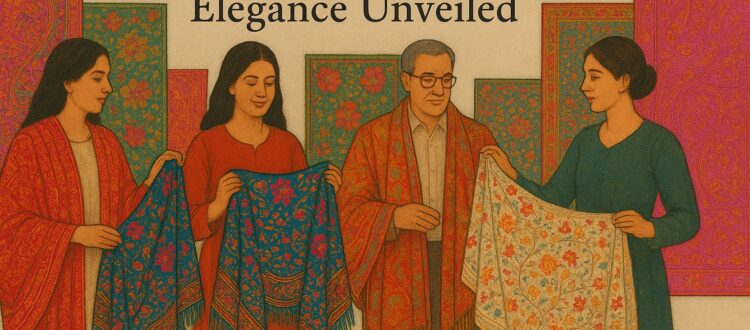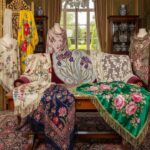The Elegance of Indian Shawls and a Preview of the Upcoming Auction
Imagine the whisper of the finest wool against skin, a tapestry of colour, and a legacy spun from the finest mountain goat undercoat. That is the magic of Indian shawls. A land of cultural diversity and heritage, Indian shawls represent this diversity in every thread. For centuries, the shawls of India, particularly those originating from the majestic Kashmir Valley, have held a mystical allure, adorning royalty and captivating connoisseurs across the globe. From the legendary luxury of the Pashmina shawl to the meticulous marvel of the Kani shawl, these exquisite textiles are far more than accessories; they are woven narratives of tradition.
This October, Giftex’s Online Auction brings this legacy alive once again. Among its Textile Category offerings, exquisite Indian shawls—some antique, some rare, all remarkable—will be showcased to collectors and fashion enthusiasts worldwide. In this blog, we’ll uncover the centuries-old allure of Indian shawls, preview the top highlights from the upcoming auction, and share practical styling and care tips to help you wear and preserve these treasures with grace.
The Indian Shawl: A Long Affair of Culture & Elegance
The Indian shawl, a rectangular piece of clothing, originated in the northern region of the Indian subcontinent. India’s connection with shawls is centuries old, weaving together tradition, artistry, and identity. The valleys of Kashmir were once the heart of this craft, where master artisans hand-spun the fine fleece of Himalayan goats into the legendary Pashmina shawls.
The term ‘Pashmina’ itself is derived from the Persian word Pashm, meaning ‘soft gold’ or ‘wool’. This wool, sourced from the undercoat of the Changthangi goat (Capra Hircus) found in the high-altitude plains of Ladakh, is one of the finest natural fibres in the world.
The zenith of the Kashmiri shawl’s fame arrived with the Mughal Empire, where emperors like Akbar became avid patrons and collectors. The intricate woven designs, known as Jamawar, with shawl motifs depicting paisleys (Buta or Kairi), and other geometric patterns, were patronized and refined under royal decree. Today, collectors and enthusiasts chase these shawls for the same reasons they were cherished in the past: rarity, artistry, and their unmatched ability to transform any outfit.
Also Read: The Timeless Elegance of Pashmina Shawls
The Allure of Shawls: Why They Endure
- Timelessness – A shawl never goes out of style. Whether worn over a kurta, sari, or evening gown, it adds a finishing touch that feels effortless.
- Versatility – One shawl, many looks: drape it, wrap it, knot it, or let it flow.
- Cultural richness – Every shawl tells a story—of artisans, regions, and techniques that date back centuries.
And this is exactly what Giftex’s upcoming October Online Auction celebrates: the magic and allure of Indian shawls in their many forms.
Giftex Online Auction – October Textile Highlights
This October, Giftex presents its “World of Collectibles” online auction, spotlighting exquisite shawls in its Textile category. Below is a preview of three standout entries—each distinct in technique, palette, and personality—offering collectors and aesthetes a rich palette of choices.
Spotlight on Shawls at the Giftex Auction
- Kashmiri Elegance: Red Palledar Shawl

The Kani technique is among the crown jewels of Kashmiri weaving. Artisans use small wooden bobbins (kanis) to interlock coloured wefts, producing precise motifs that look woven rather than embroidered. A “palledar” shawl, often made from luxurious pashmina wool, is a long, hand-embroidered shawl featuring prominent decorative borders or ends called “pallu” or “palla”
Design & Craftsmanship:
- This large palledar shawl embodies the grandeur of Kashmiri Kani weaving.
- The shawl features a broad central red field, unembellished, which acts as a striking backdrop to highlight the ornate woven borders.
- Along the edges, the design bursts into life with an elaborate palledar pattern—a hallmark of Kashmiri artistry—dominated by large, elongated paisleys (boteh motifs).
Colours:
- The deep, dark red base gives the shawl a regal foundation, often associated with luxury, warmth, and power in Indian textiles.
- The paisleys are woven in earthy tones of beige, ivory, and muted green, which contrast beautifully with the red field.
Significance:
- Palledar shawls are deeply tied to Mughal-era opulence, when Kashmiri shawls were prized by emperors, nobility, and later by European aristocracy.
- The paisley motif is symbolic: rooted in Persian design, it represents fertility, eternity, and the interconnectedness of life.
This large, dark red palledar shawl is not just a winter accessory—it is a statement of heritage.
- Vibrancy of Colours: A Gulabkar Kashmiri Kani Shawl

A Gulabkar Kashmiri Kani shawl is a specific type of traditional handwoven shawl from Kashmir, characterized by its intricate designs and vibrant colours, particularly those featuring pinks, reds, and oranges. The term ‘Gulabkar’ refers to its distinctive colour palette featuring floral motifs.
Design & Craftsmanship
- This Gulabkar Kashmiri Kani Shawl, woven in hand-spun pashmina, is a textile that represents the height of Kashmiri artistry.
- A dense, all-over pattern of elaborate floral motifs characterizes the design.
- The shawl showcases the Kani weaving tradition.
- The pattern is dominated by Gulab (rose) motifs, arranged in a scattered but harmonious layout across the field. These rose-inspired blossoms are interspersed with small buds, creepers, and foliage.
Colours:
- The base is a serene sea green, which sets a cooling backdrop for the vivid embroidery.
- The flowers and vines burst in a kaleidoscope of colours:
- Bright pink, rose pink, and magenta dominate the floral accents.
- Orange and red add warmth and vibrancy.
Significance:
- Heritage of Kani Weaving: The Kani technique, centuries old, is among the most laborious and revered shawl-making methods in Kashmir.
- The Rose Motif: The rose, central to the design, is a long-standing symbol in Persian and Kashmiri aesthetics, associated with beauty, love, and timeless elegance.
- Luxury of Pashmina: Hand-spun and handwoven pashmina carries unmatched softness and warmth, making the shawl not just a garment but a treasured heirloom.
- Elegance Redefined: Lucknowakar Black Pashmina Do Rukha Shawl

This Lucknowakar Black Pashmina Do Rukha Shawl, around 50 years old, carries both artistic and cultural significance
Design:
- The shawl is richly embroidered with a dense, all-over floral and paisley pattern.
- The motifs include large blossoms, leaf clusters, and stylized paisleys (buta), a hallmark of Kashmiri and Lucknowi embroidery traditions.
- The embroidery creates a “garden” effect—flowers and vines appear to be blooming across the surface.
- It has a broad border on all four sides, intricately filled with continuous floral and paisley designs, creating a frame-like effect around the central field.
Colours:
The base fabric is black, which makes the embroidery pop vibrantly.
The thread work features a wide spectrum:
- Pink, red, and magenta for flowers and paisleys
- Greens and blues for leaves and foliage
- Yellow and gold tones for highlights
Significance:
- Lucknowakar Style: While Kashmiri shawls are more famous, Lucknow also developed a fine tradition of needlework, often blending Kashmiri designs with the region’s own artistic sensibilities.
- Pashmina Wool: The fabric itself is made from fine Pashmina (handwoven from the undercoat of Himalayan goats), prized for softness, warmth, and luxury.
- Heritage Value: A 50-year-old piece like this is not just a garment but a cultural artefact, representing India’s textile artistry and the continuity of hand embroidery traditions.
Styling Tips: How to Wear Shawls with Flair
Shawls are versatile, and when styled thoughtfully, they elevate any outfit. Here are a few styling cues for different occasions:
- Casual Day Out
Pair a floral Pashmina with jeans, a white shirt, and boots.
Drape loosely over the shoulders or knot around the neck like a scarf.
- Formal or Work Setting
Opt for a subtle palledar or monochrome embroidered shawl.
Drape it neatly over both shoulders with structured trousers or a sari.
- Festive or Celebration Wear
Bold Kani or Gulabkar shawls shine at weddings and celebrations.
Style with lehengas, silk saris, or even evening gowns.
Caring for Your Shawl: Preserve the Legacy
An authentic Indian shawl, especially one made from Pashmina, deserves care and attention:
- Storage – Always fold and store in a muslin cloth; avoid hanging to prevent stretching.
- Moth Protection – Use cedar blocks or natural repellents to protect from moths.
- Cleaning – Dry clean only. Avoid harsh detergents and never wring the fabric.
- Handling – Keep away from perfumes or sprays that may damage fibers.
Woven Threads of Heritage
The Indian shawl, in all its iterations—from the humble elegance of a Pashmina shawl to the intricate complexity of a Kani masterwork—remains a profound symbol of India’s textile genius. Each shawl is a whisper from the past, a dedication by a master artisan, and a tangible link to a rich cultural heritage. To own one, especially a vintage shawl like those coming up at the Giftex auction, is to hold a fragment of that timeless story. More than luxury, it is a piece of art that keeps you warm while connecting you to centuries of tradition.
Don’t just wear a shawl—wear a legacy.






